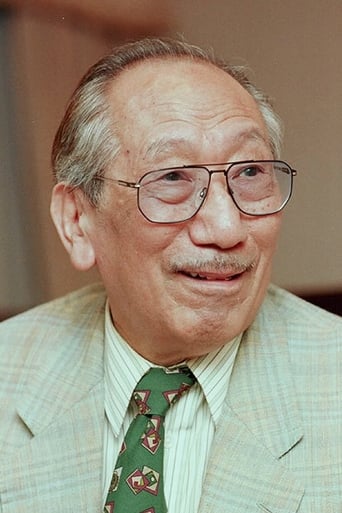Diagonaldi
Very well executed
2freensel
I saw this movie before reading any reviews, and I thought it was very funny. I was very surprised to see the overwhelmingly negative reviews this film received from critics.
ThedevilChoose
When a movie has you begging for it to end not even half way through it's pure crap. We've all seen this movie and this characters millions of times, nothing new in it. Don't waste your time.
Catangro
After playing with our expectations, this turns out to be a very different sort of film.
charlesem
Having seen House (Nobuhiko Obayashi, 1977) and In the Realm of the Senses (Nagisa Oshima, 1976), I had to see what the director of the former -- a brightly colored, over-the-top horror film, set to a bubble-gum pop soundtrack, about a gaggle of Japanese schoolgirls who find themselves in a haunted house and proceed to die in various colorful and inventive ways -- would do with the latter -- a sexually explicit account, with full nudity and unsimulated copulation, of the crime of Sada Abe, who in 1936 killed her lover, Kichizo Ishido, carved their names on his body, and cut off his genitals, carrying them around with her until she was arrested. The story of Sada has been the subject of numerous books and at least five movies in Japan, after her trial -- which resulted in five years in prison -- set off a nationwide sensation, turning her into a kind of folk hero. The result is a curiously show-offy film that Obayashi fills with all manner of tricks: switches from color to black-and-white, characters breaking the fourth wall, eccentric cuts and startling shifts of tone, and deliberate violations of cinematic convention. In one scene, Sada (Hitomi Kuroki) and her lover, whose name has been changed to Tatsuzo (Tsurutaro Kataoka) in the film, are walking along the street together. The camera follows Tatsuzo from right to left as he speaks, then cuts to Sada as she replies. Film convention calls for a shot followed by a reverse shot, in which we see first Tatsuzo and then Sada from different angles. Instead, Obayashi cuts to Sada, filmed from the same angle and still traveling from right to left, as if she has somehow physically replaced Tatsuzo. This and similar impossible cuts and angles in the film are probably meant to suggest Sada's identification with her lover. Tone shifts mark the film from the beginning: It opens with 14-year-old Sada's rape by a teenage boy, a harrowing scene that is nevertheless somehow played as if it were comic, just as later Sada's work as a prostitute shifts into comic mode with speeded-up action and cuts to a voyeur watching from his hiding place, and a fight with Tatsuzo's wife becomes almost slapstick. Obayashi seems determined to avoid anything that smacks of melodrama or sentimentality. but not always successfully. The screenplay, by Yuko Nishizawa, tries to add depth to Sada's story by inventing a young medical student, Okada (Kippei Shina), who tends to her after her rape. He becomes a symbol of Sada's loss of anything but physical love when he is forced to part from her: He gives her his scalpel and has her mime cutting out his heart and taking it with her -- an obvious foreshadowing of her actual use of the scalpel on Tatsuzo. Sada spends much of the film hoping to be reunited with Okada, only to find that he has leprosy and has been sent to an island on the Inland Sea for quarantine. The film ends with a shot of an elderly woman looking out across the sea to the island. In contrast to Oshima's In the Realm of the Senses, Obayashi's film avoids nudity, but this only serves to add another layer of distance between the viewer and Sada. Kuroki, a beautiful young actress, does what she can with the role, but the constant camera tricks and the limitations imposed by the script never let us get more than a superficial glimpse of what drove Sada Abe to act as she did.
sitenoise
Forget that this is another entry in the dramatization of Sada Abe's life and crime of killing her lover and cutting off his man-parts, most infamously portrayed in the sexually explicit In the Realm of the Senses, and ignore all the commentary that molds the story into a historical and social context for your academic pleasure, and never mind that these kinds of stories always start off with the girl being raped as a teenager. All those things involve too much thinking. Just kick back and enjoy this as another odd but fairly well-executed film by director Nobuhiko Obayashi.The first things you'll notice about the film are the narrative and filmic techniques used by Obayashi. Characters break the Fourth Wall; there's a mix of black & white and color photography which is interesting and useful some times and random at others; some jump-cut editing use is mostly abandoned after the first act; the costuming, both traditional and modern, is gorgeous; there's a fabulous stop-motion sequence in the middle that starts with Sada reading a book while her lover sits near her having a snack, they do the hanky-panky and then resume their initial activities, and there are several moments of Keystone Kops style comedy. After that you should find it to be a fascinating character study of a strong and intelligent woman.Hitomi Kuroki is amazing as Sada. Her characterization remains a constant as she effortlessly transitions through the varied styles of presentation Obayashi employs. She is always elegant, beautiful, sensuous, and in control. She is also very genuine, which comes off as quite sexy. (For the curious, there is zero nudity in this version of the story, not even a glimpse of Sada's notoriously cute butt. The closest we get, in a brilliant directorial move, is an odd-angled, extreme close-up of her fully kimonoed posterior. There are lots of bare shoulders and legs and several sex scenes but they are mostly played either artfully or comically.) Sada may serve it's nominal content respectfully and respectably but it comes off so much more as a stylized film than a biography that if it's approached with an educational curiosity its style may frustrate. Watch it for the whimsical stylings of the director and the lovely and remarkable performance of Hitomi Kuroki.
dr_salter
I feel that a director's job through a movie lens, is not to tell the devil he/she is evil but to make a film that tells the viewer that evil exists and how we find it in us. This movie shows a lot more than we think we know about human nature. This movie is based on the true story of a woman called Sada Abe -played inimitably by top-notch Hitomi Kuroki. Sada is sensuously beautiful in an unmade-up way [no makeup plastered on her]. In 1936, Sada strangled her lover Tatsuzo [played by the short in height but powerfully muscled actor Tsurutaro Kataoka] and cut off his penis and scrotum [ouch!] and carried them around in a paper bag shoved into her kimono belt.Director Nobuhiko Obayashi's unusually beautiful smooth film with some odd camera angles -follows the young woman, Sada's life from her loss of virginity in a rape at 14 to life as a prostitute and later a mistress - from a fateful meeting with the man whom she loves, to his eventual murder. The scene where Sada, who works in her lover's restaurant, wrestles, pulls hair, and judo chops Tatsuzo's jealous wife to the bamboo floor boards and kicks her in the ribs till the wife jumps up strangling and slapping Sada's face -is a must see and really wonderful! The movie has this quirky, way of bringing a relaxed and usually unseen side of Japanese life - showing characters dressed in a mix of western & traditional dress: the costuming is delicious. Lots of love scenes and erotic rolling on the floor mats but not much nudity [no genitals etc] just fine creamy shoulders and legs -truely sensual. These events took place during a period of war, when Japan invaded Manchuria, economic depression, public unease and growing militarism, with references to the assassination of Cabinet Ministers by groups of 'Young Officers' which begins the nucleus of the future WW II Fascist regime. The action was set in a time when the young were questioning eastern traditions and wanting western consumer goods [Saba eats bags and bags of mini sugar rolled donuts]. It was the time of unrest and confusion and when public opinion was, at best, unpredictable.When the details of her crime are printed in nationwide newspapers -Sada became an overnight sensation as a 'love goddess' and was granted a lenient sentence for her crime of passion. The actor who plays her wandering vagabond friend is dressed in a combination of Japanese peasant baggy pants and leggings with a shawl and topped off with an Al Capone hat -I just loved the whole package - Japanese with English subtitles.
Mozjoukine
The contrast between Oshima's IN THE REALM OF THE SENSES and the delicacy and stylishness of this film, which treats the same subject, is striking.
Whether the story of a woman who cuts off her lover's privates is better handled by a ham fisted celebrity pornographer is questionable.
Nobuhiko Obayashi's version comes complete with Brechtian devices (singing characters, narration by actors explaining their roles , switches to colour in which the blood remains black) and an elegant star turn by Miss Hitomi Kuroki, all of which make the piece intriguing and show considerable skill.It hasn't attracted any of the censor controversy of the better know (and dodgy) version and hasn't earned it's makers a spot in film histories. Too bad.





